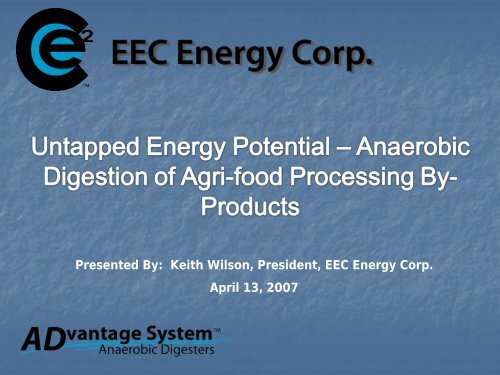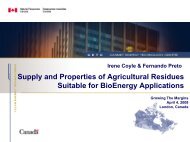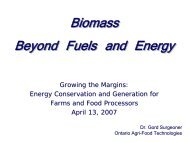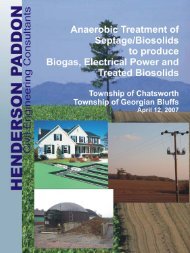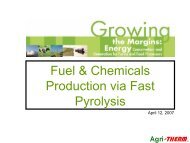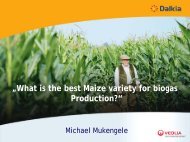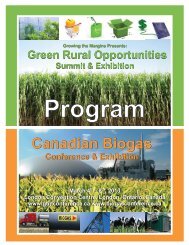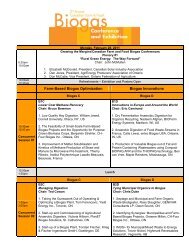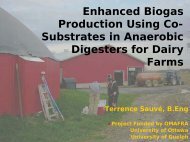Anaerobic Digestion of Agri-food Processing By-Products
Anaerobic Digestion of Agri-food Processing By-Products
Anaerobic Digestion of Agri-food Processing By-Products
You also want an ePaper? Increase the reach of your titles
YUMPU automatically turns print PDFs into web optimized ePapers that Google loves.
Presented <strong>By</strong>: Keith Wilson, President, EEC Energy Corp.<br />
April 13, 2007
‣ Introduction<br />
‣ <strong>Agri</strong>-<strong>food</strong> <strong>Processing</strong> <strong>By</strong>-<strong>Products</strong> in Ontario – an Untapped<br />
Energy Source<br />
‣ The ADvantage System <strong>Anaerobic</strong> Digester – Overview<br />
‣ EEC Energy Grain Handling <strong>By</strong>-products Test
According to a study by the Ontario Ministry <strong>of</strong> <strong>Agri</strong>culture and Rural<br />
Affairs (OMAFRA), there is almost 2,300,000 tonnes <strong>of</strong> organic waste<br />
produced by agri-<strong>food</strong> companies in Ontario annually. The potential energy<br />
value <strong>of</strong> that organic waste processed by AD translates into:<br />
‣ Over 3.6 Million Megawatts <strong>of</strong> Electricity Annually<br />
‣ Over 5 Million Megawatts <strong>of</strong> Thermal Energy Annually (using CHP units)<br />
EEC Energy estimates that today’s energy value <strong>of</strong> the Biogas from that waste<br />
is almost 100,000 Gigajoules annually.
Types <strong>of</strong> organic material for AD Systems:<br />
Food <strong>Processing</strong>:<br />
Fruit & Vegetable <strong>Processing</strong><br />
Brewery Waste<br />
Malt Plant Waste<br />
Abattoirs<br />
Sugar <strong>Processing</strong><br />
<strong>Agri</strong>cultural:<br />
Dairy<br />
Poultry<br />
Crop & Crop Residuals<br />
Municipal/Industrial:<br />
Sewage Sludge (after treatment)<br />
Organic Landfill Waste<br />
Restaurant Waste (fats/oils)<br />
Grain Elevators<br />
Dairy/Cheese <strong>Processing</strong><br />
Corn & Potato <strong>Processing</strong><br />
Fish <strong>Processing</strong><br />
Beef<br />
Swine<br />
Silage<br />
“Wet” Kitchen Waste<br />
Lagoon Treatment
Unique Features and Benefits:<br />
‣ Modular Design<br />
‣ Easily expandable to handle increased waste volumes<br />
‣ Processes different waste streams in separate digesters<br />
‣ Completely automated – on or <strong>of</strong>f-site control and monitoring<br />
‣ Flexible design – digesters are<br />
standard, complete flexibility to<br />
integrate front & back-end<br />
processing into current operations<br />
‣ Indoor operation – mitigate odours<br />
associated with digestate handling
Unique Features and Benefits:<br />
‣ High Temperature Operation - 55° to 60° Celsius<br />
‣ Shorter Hydraulic Retention Time (HRT) – typically 4-7 days<br />
‣ Complete Pathogen Destruction Rate (99.999%)<br />
‣ 2/3 Less Digester Volume required compared to Mesophilic systems<br />
‣ Increased biogas yields – typically 20-25% higher than Mesophilic<br />
‣ Increased biogas quality at 650-750 BTU’s/ft3
In 2005, EEC Energy<br />
began the R & D<br />
Project to test the<br />
energy potential and<br />
business case for<br />
operating an AD<br />
System on grain dust<br />
from the local grain<br />
handling industry
TEST PURPOSE:<br />
To determine the latent energy potential (in Therms/Ton) through anaerobic digestion<br />
<strong>of</strong> pelletized barley dust as a sole substrate, as supplied by a local grain-handling<br />
facility<br />
TEST PARAMETERS:<br />
The following tests were performed and recorded:<br />
‣ Temperature, pressure and PH <strong>of</strong> blend tank, digester and biogas<br />
‣ Quantity, quality and BTU value <strong>of</strong> biogas production<br />
‣ Solids recovery from digestate<br />
TEST TIMELINE:<br />
The barley substrate was first introduced into the digester on Sept. 11/05. The<br />
digester was gradually weaned <strong>of</strong>f manure and onto the new substrate over the<br />
next few weeks.
OBSERVATIONS:<br />
‣ The digestion <strong>of</strong> the infeed was immediate and very fast<br />
‣ In the 2 hour period following the batch infeed, excess biogas was generated<br />
‣ Also, during this time, the boiler could not consume all the biogas being<br />
generated and the excess was vented to atmosphere through the safety stack.<br />
‣ During this first 2 hours, the boiler temperature did not rise relative to the extra<br />
gas being consumed and in fact, it occasionally dropped.<br />
‣ There was little recoverable solids from the digester.<br />
‣ Even though there was a large recycled digestate component to the infeed, the<br />
pH <strong>of</strong> the digester remained stable.
Biogas Production (cu.ft./# Infeed)<br />
(8.66 Avg.)<br />
Cu. Ft. Biogas<br />
14<br />
12<br />
10<br />
8<br />
6<br />
4<br />
2<br />
0<br />
1 3 5 7 9 11 13 15 17 19 21 23<br />
Hours from Infeed
Biogas Production (BTU's/Cu.Ft.)<br />
(692 Avg.)<br />
BTU's/Cu.Ft.<br />
900<br />
800<br />
700<br />
600<br />
500<br />
400<br />
300<br />
200<br />
100<br />
0<br />
1 3 5 7 9 11 13 15 17 19 21 23<br />
Hours from Infeed
Biogas Production (Therms/Ton)<br />
(122 Avg.)<br />
Therms/Ton Infeed<br />
250<br />
200<br />
150<br />
100<br />
50<br />
0<br />
1 3 5 7 9 11 13 15 17 19 21 23<br />
Hours from Infeed
The results <strong>of</strong><br />
our research<br />
demonstrate a<br />
strong case for<br />
grain waste as a<br />
feedstock for AD<br />
Systems!


